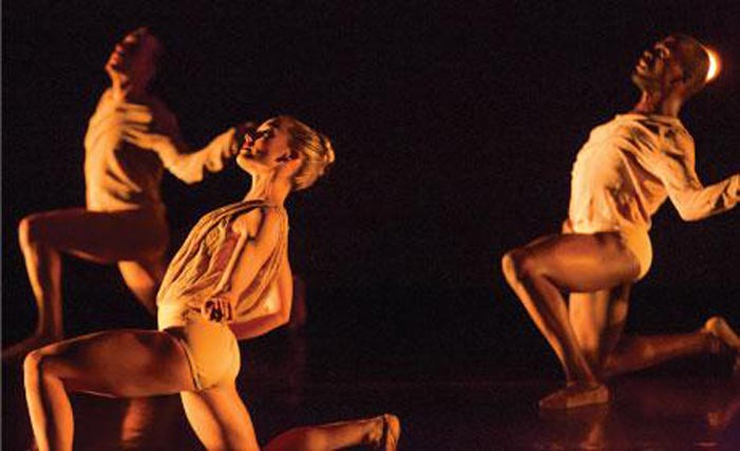
“Ballet” is an unusual word used in naming the Chicago Repertory Ballet. The dancers all seem classically trained, but their strength definitely lies in contemporary movement and commitment to the work at hand.
In this day, it is a benefit to be classically trained as can be seen in some of the major dance companies such as Netherlands Dance Theater or Hubbard Street Dance Chicago.
Not a ballet step needs to be done, but the use of the legs and feet, the coordination (or lack thereof), and the range of movement continue to separate the classically trained technician from the well-rounded mover.
Last Saturday (July 25), the industrious director, Wade Schaaf, offered a mix of dance elements utilizing the “something for everyone” methodology in performance at South Miami-Dade Cultural Arts Center.
The opening piece, Still Life (2015) choreographed by Tenley Dorrill, and the winner of a choreographic competition by CRB, featured three couples and one solo female in a black box setting. The piece offered a closer look at relationships. The choreography was simple with gestures often replacing movement. The gestures were more prevalent in the first half of the performance. The climax was a duet by Greg Blackmon and Jacqueline Stewart to an adeptly coordinated conversation in French. Not resolving any issue, one believes that the dynamics of the relationship will be to “keep trying.” Dorrill is well on her way to finding her unique choreographic voice and vocabulary.
Dancer, Net (3)(2011) choreographed by Schaaf was next on the program. Perhaps it was one of three solos as the program suggests? While not a new concept in beginning a solo wrapped in netting and breaking free, the use of Saint-Saëns' Dying Swan music, sparsely placed feathers on the costume, brittle and sometimes repetitive movements, and even the slight touch of humor made for an enjoyable emotional journey. The contrast of freedom to death added some thought, though it was an easy piece to watch. Was the swan/bird caught and breaking free from the net or simply being born? No matter, the solo worked. The audience was captivated and Stewart was transformative.

The third piece was a duet choreographed by Stewart with Blackmon and Danielle Matthews dancing over, around and amidst a single light on the stage. The piece, entitled It’s Not Enough To Close Your Eyes, implies that one is always seen and light is constantly being shed. An interesting concept that, again, used gestures and comfortable choreography. Stewart could challenge her dancer’s ability with more extensive dynamics to build the relationship and tell her story.
Wasteland (2015), choreographed by Schaaf, did not leave anything to the imagination. With nude costumes, a mixed score of classical and contemporary music overridden with crowd and bass like noise, the use of haze and shadows, the dancers spent much time twitching, wandering, crawling and falling to the floor. There was a mood evoked. The piece definitely suggests that there is not much hope for the future if we continue at this pace.
The longest and most vivaciously diverse piece on the program was The Four Seasons, choreographed by Schaaf with music recomposed from the traditional Vivaldi score by Max Richter.
There have been many renditions in dance of The Four Seasons to both Vivaldi and Glazunov. This presentation was an admirable foray into a very known territory. Much has also been written about the Richter rendition of The Four Seasons. It is agreed that with all due respect to the original score, Richter’s ode to Vivaldi is refreshing and worthwhile. The colorful skirts and beige tops for the females and patterned T-shirts blending into flamelike patterned bellbottoms for the men, made one wonder if the dancers represented something or if there was simply a joyous mood being evoked in the spring section.
It was refreshing to see the dancers dance, to see patterns, movement, various solos and duets, and the occasional ease on the eye of unison work. This was the most “balletic” dance — even using some true ballet vocabulary: brisé, arabesque, chaîné turns and the ever visible preparation into a pirouette — perhaps not necessary, but delivered with energy and exuberance, nonetheless.
It was truly up to the dance to smoothly blend one season into the next. The beige costumes, the hot yellow lighting and the slow, heavy port de bras clearly evoked the heat of summer.
The first male solo on the program leading into a dynamic duet was rousing and stimulating with extensive food for the eye in intricacy and level changes. Kudos to Becky Mikos for her smile and lightness in her solo and group material.
Winter was a cool blue with the same commitment in deliverance to abundance in movement and the connections that are made when working with a group.
This Four Seasons is a lighthearted composition that moves through various styles of dance just as the seasons surprise us with unexpected changes.
Unfortunately, the evening's program given out was a one-page notice with limited information and did not include many of the hard-working dancers' names, nor could they be found on the CRB website.
The South Miami-Dade Cultural Arts Center & Culture Shock Miami presented the newly formed (2011) Chicago Repertory Ballet for a first visit to South Florida. The Arts Center with its sleek and contemporary lines is an excellent venue for repertory and contemporary dance companies offering good sight lines, spaciousness without losing intimacy and efficient and courteous ushers — an important aspect of any performance experience.
The Chicago Repertory Ballet next moves to Vero Beach for continued classes, repertory work and performances. Try to catch them.
 MAIN MENU
MAIN MENU

